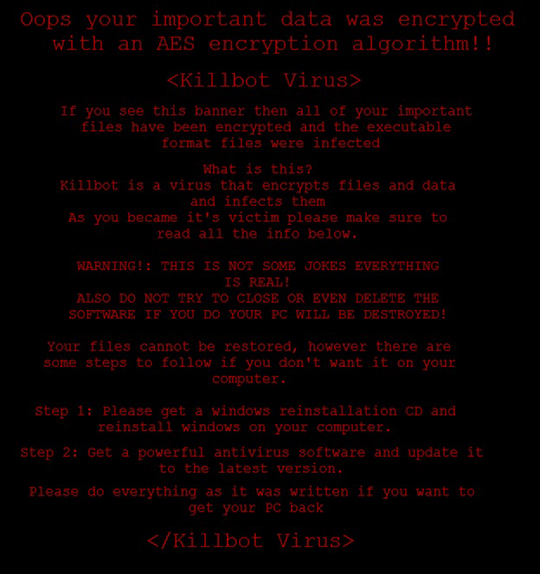TROJ_FAKEKILLBOT.THAORAH
Trojan.FakeAV (NORTON), Trojan:Win32/Tiggre!rfn (MICROSOFT),
Windows


Threat Type: Trojan
Destructiveness: No
Encrypted: No
In the wild: Yes
OVERVIEW
Dropped by other malware
This Trojan arrives on a system as a file dropped by other malware or as a file downloaded unknowingly by users when visiting malicious sites.
TECHNICAL DETAILS
20,992 bytes
EXE
Yes
12 Jan 2018
Drops files
Arrival Details
This Trojan arrives on a system as a file dropped by other malware or as a file downloaded unknowingly by users when visiting malicious sites.
Other Details
This Trojan does the following:
- Once executed, this Trojan will display a transparent window prompting the user of the file encryption. It does not encrypt files but once the window is closed, it attempts to delete all registry keys from the machine using the commands:
- cmd.exe /C reg delete HKEY_CURRENT_CONFIG
- cmd.exe /C reg delete HKEY_CLASSES_ROOT
- cmd.exe /C reg delete HKEY_USERS
- cmd.exe /C reg delete HKEY_CURRENT_USER
- cmd.exe /C reg delete HKEY_LOCAL_MACHINE
NOTES:
The encryption/infection note shown as a transparent window.

SOLUTION
9.850
13.912.04
18 Jan 2018
13.913.00
19 Jan 2018
Step 1
Before doing any scans, Windows XP, Windows Vista, and Windows 7 users must disable System Restore to allow full scanning of their computers.
Step 2
Identify and terminate files detected as TROJ_FAKEKILLBOT.THAORAH
- Windows Task Manager may not display all running processes. In this case, please use a third-party process viewer, preferably Process Explorer, to terminate the malware/grayware/spyware file. You may download the said tool here.
- If the detected file is displayed in either Windows Task Manager or Process Explorer but you cannot delete it, restart your computer in safe mode. To do this, refer to this link for the complete steps.
- If the detected file is not displayed in either Windows Task Manager or Process Explorer, continue doing the next steps.
Step 3
Restore these deleted registry keys/values from backup
*Note: Only Microsoft-related keys/values will be restored. If the malware/grayware also deleted registry keys/values related to programs that are not from Microsoft, please reinstall those programs on your computer.
- HKEY_CURRENT_CONFIG
- HKEY_CLASSES_ROOT
- HKEY_USERS
- HKEY_CURRENT_USER
- HKEY_LOCAL_MACHINE
Step 4
Scan your computer with your Trend Micro product to delete files detected as TROJ_FAKEKILLBOT.THAORAH. If the detected files have already been cleaned, deleted, or quarantined by your Trend Micro product, no further step is required. You may opt to simply delete the quarantined files. Please check the following Trend Micro Support pages for more information:
Did this description help? Tell us how we did.

